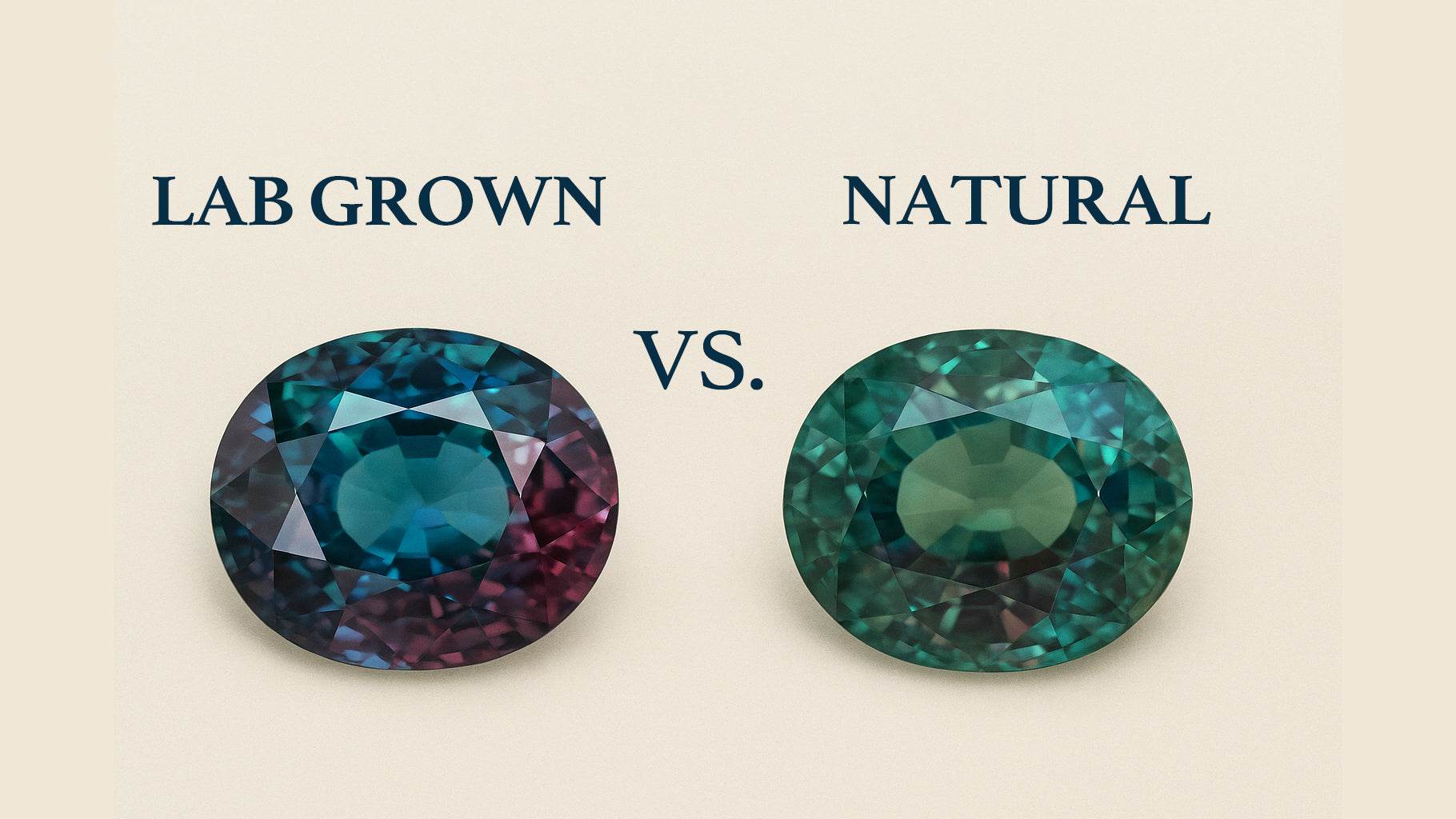
Lab Grown Vs. Natural Alexandrites: What is the Difference?
Alexandrite, which can shift from green in sunlight to red under incandescent light, is often called the "emerald by day, ruby by night". Its extraordinary color-change phenomenon captivates gem enthusiasts and remains one of the most enchanting and sought-after gemstones in the jewelry world.
However, because natural alexandrite is extremely rare and expensive, lab-grown alexandrite has become increasingly common in recent years. Lab-grown alexandrite has the same chemical composition and physical properties as natural alexandrite, making it a more affordable alternative to the natural stone.
At this point, many jewelry lovers may wonder: what’s the difference between lab-grown alexandrite and natural alexandrite? Which should you choose? In this guide, we will compare lab-grown vs. natural alexandrite across formation, appearance, rarity, durability, and price, so you can make the right choice for your next alexandrite jewelry piece.
What is Lab Grown Alexandrite?
Lab grown alexandrite is a synthetic gemstone created in controlled laboratory environments using advanced technological processes. Scientists recreate the same chemical composition, crystal structure, and physical properties found in natural alexandrite through methods such as the Czochralski process or flux growth technique. These sophisticated procedures involve melting the raw materials at extremely high temperatures and carefully controlling the cooling process to form crystals with the characteristic chrysoberyl structure.
The laboratory environment allows gemologists to produce alexandrite with exceptional clarity and color-changing properties while maintaining the same beryllium aluminum oxide composition as natural stones. Modern synthetic alexandrite exhibits the same pleochroic characteristics that make natural alexandrite so prized, displaying vivid color shifts from green to red depending on the light source. The entire creation process typically takes several weeks to months, resulting in gemstones that are chemically and optically identical to their natural counterparts.
What is Natural Alexandrite?
Natural alexandrite forms deep within the Earth's crust under extremely rare geological conditions that require the presence of both beryllium and chromium in the same location. This extraordinary combination occurs so infrequently that natural alexandrite ranks among the rarest gemstones on Earth, even more scarce than diamonds. The formation process takes millions of years as these elements combine under intense heat and pressure to create the unique chrysoberyl variety that exhibits the famous color-changing phenomenon.
Most natural alexandrite originates from a few select locations worldwide, with Russia's Ural Mountains being the original and most famous source. Other significant deposits have been discovered in Brazil, Sri Lanka, Madagascar, and Tanzania, though each location produces stones with slightly different characteristics and color intensities. The rarity of suitable geological conditions means that high-quality natural alexandrite commands premium prices in the gemstone market, with exceptional specimens reaching values that surpass many precious stones.
Similarities Between Lab Grown Alexandrite and Natural Alexandrite
Both lab grown and natural alexandrite share identical chemical compositions of beryllium aluminum oxide with trace amounts of chromium responsible for the color-changing properties. This fundamental similarity means that both varieties exhibit the same mesmerizing pleochroic effect, shifting from green hues in daylight to red tones under incandescent lighting. The hardness rating of 8.5 on the Mohs scale remains consistent between both types, making them equally suitable for everyday jewelry wear and ensuring excellent durability.
Gemologically, both lab grown and natural alexandrite display the same optical properties, including refractive index, specific gravity, and crystal structure. Under standard gemological testing, both varieties will exhibit identical readings for most properties, making them virtually indistinguishable without specialized equipment. The beautiful color play that makes alexandrite so desirable appears equally stunning in both synthetic and natural stones, with modern laboratory techniques producing synthetic alexandrite that rivals the finest natural specimens in terms of color intensity and clarity.
Differences Between Lab Grown Alexandrite and Natural Alexandrite
Origin and Formation Time
The most fundamental difference lies in their origins. Natural alexandrite requires millions of years of geological processes and extremely rare conditions where beryllium and chromium coexist in the Earth's crust. Laboratory alexandrite forms in controlled environments within weeks or months using advanced technological processes that replicate natural conditions.
Rarity and Availability
Natural alexandrite ranks among the world's rarest gemstones, with high-quality specimens becoming increasingly scarce as mines are depleted. Lab grown alexandrite can be produced on demand, making it readily available in various sizes and qualities without the constraints of natural deposits.
Price Differences
Natural alexandrite commands significantly higher prices due to its extreme rarity, with fine specimens often costing tens of thousands of dollars per carat. Lab grown alexandrite offers the same beauty and properties at a fraction of the cost, typically ranging from hundreds to low thousands of dollars per carat depending on size and quality.
Inclusions and Characteristics
Natural alexandrite often contains inclusions, internal flaws, or growth patterns that formed during its lengthy creation process. These natural birthmarks can sometimes help identify authentic stones but may affect clarity. Lab grown alexandrite typically exhibits fewer inclusions and more consistent clarity due to controlled growing conditions.
Investment Value
Natural alexandrite generally holds and appreciates in value over time due to its rarity and historical significance in the gemstone market. Lab grown alexandrite, while beautiful, typically does not maintain the same investment potential as natural stones.
Detection Methods
Gemological laboratories can distinguish between natural and lab grown alexandrite using specialized equipment that detects growth patterns, trace elements, and other identifying characteristics. Advanced testing methods such as photoluminescence spectroscopy can reveal the synthetic origin of laboratory-created stones.
Lab Grown Vs. Natural Alexandrite: Which Should I Choose?
The decision between lab grown and natural alexandrite depends on your personal priorities, budget, and intended use. Choose natural alexandrite if you value rarity, investment potential, and the romantic notion of owning a gemstone formed over millions of years. Natural alexandrite appeals to collectors, those celebrating milestone occasions, or individuals who prioritize traditional gemstone heritage and potential value appreciation.
Lab grown alexandrite proves ideal for those who prioritize beauty, ethical considerations, and budget consciousness. If you desire the stunning color-changing properties of alexandrite without the premium price tag, synthetic stones offer exceptional value. Lab grown options also appeal to environmentally conscious consumers who prefer gemstones created without mining impacts.
Consider your lifestyle and jewelry wearing habits when making this decision. For everyday wear pieces or fashion jewelry, lab grown alexandrite provides beauty and durability at accessible prices. For heirloom pieces, engagement rings, or significant milestone jewelry, the rarity and prestige of natural alexandrite might justify the higher investment.
LUO Jewelry Lab-grown Alexandrite Jewelry
LUO Jewelry proudly presents an exceptional collection of lab grown alexandrite jewelry that combines cutting-edge gemstone technology with timeless design excellence. Our commitment to quality and craftsmanship ensures that each piece showcases the mesmerizing color-changing properties of alexandrite while offering outstanding value and ethical sourcing.
Lab Grown Alexandrite Rings
LUO Jewelry's lab grown alexandrite ring collection features stunning designs that highlight the gemstone's remarkable color-changing abilities. From elegant solitaire settings that showcase the stone's natural beauty to intricate vintage-inspired designs with delicate metalwork, each ring is crafted to perfection. The collection includes engagement rings with lab grown alexandrite center stones surrounded by diamonds, creating breathtaking pieces that symbolize unique and enduring love. Classic three-stone designs featuring alexandrite flanked by diamonds offer timeless elegance, while modern tension settings create contemporary statements that emphasize the gemstone's striking optical properties.
Lab Grown Alexandrite Earrings
The lab grown alexandrite earring collection showcases the gemstone in various styles designed to complement different face shapes and personal preferences. Delicate stud earrings highlight the pure beauty of alexandrite's color change, while drop earrings create elegant movement that catches light from multiple angles. Chandelier designs incorporate multiple alexandrite stones with diamond accents, creating dramatic pieces perfect for special occasions. Hoop earrings featuring alexandrite accents provide modern sophistication, and vintage-inspired designs with milgrain details offer romantic charm that appeals to classic jewelry enthusiasts.
Lab Grown Alexandrite Necklaces
LUO Jewelry's lab grown alexandrite necklace collection presents the gemstone in designs ranging from minimalist pendants to elaborate statement pieces. Delicate chain necklaces with single alexandrite pendants create everyday elegance, while tennis necklaces featuring graduated alexandrite stones make stunning formal jewelry. Multi-strand designs combine alexandrite with diamonds and precious metals, creating luxurious pieces suitable for the most special occasions. Lariat styles with alexandrite drops offer contemporary flair, and vintage-inspired pendant designs with intricate metalwork provide timeless appeal that transcends fashion trends.
Each lab created alexandrite jewelry in LUO Jewelry's collection undergoes rigorous quality control to ensure optimal color-changing properties, clarity, and cut quality. Their skilled artisans work with premium precious metals and employ traditional jewelry-making techniques combined with modern precision to create heirloom-quality pieces that will be treasured for generations.
Conclusion
The choice between lab grown and natural alexandrite ultimately reflects your personal values, budget, and appreciation for this remarkable gemstone's unique properties. Understanding their differences empowers you to make an informed decision that aligns with your preferences and circumstances.
Whether you choose the ancient mystique of natural alexandrite or the modern innovation of lab grown stones, you'll own one of the most fascinating gemstones in the world. LUO Jewelry's exceptional lab grown alexandrite collection demonstrates that synthetic gemstones can deliver outstanding beauty, quality, and value while making this extraordinary gemstone accessible to more jewelry lovers than ever before.
The future of alexandrite jewelry lies in recognizing that both natural and lab grown options have their place in the market, each serving different needs and preferences while celebrating the timeless appeal of this color-changing wonder.
